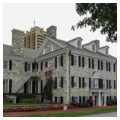Like Wilkes-Barre, the avenue along the river became the premier site for large mansions. Stephen Hills, architect for Pennsylvania's first capitol (1897 burned), designed the Greek Revival house (1840–1843) for William Griffin at 215 N. Front Street. It is adjacent to St. Stephen's Cathedral, 221 N. Front Street, the principal Episcopal church of the city. A brick Gothic Revival building dating from 1826 with a later tower, it faces the river amidst the larger mansions of its congregants. William Maclay, son-in-law of the city's namesake, built a handsome late Federal stone house at 401 N. Front Street in 1791 (1908 enlarged with a portico by Harrisburg architect Miller I. Kast). In 1863, James Cameron commissioned the towered Norman villa at number 404 in the local limestone laid in crazy-quilt fashion. Another splendid mansion is the Tudor-styled Civic Club at 642 N. Front Street, one of the few houses between the street and the river. It was built by Buffalo architect William H. Boughton as a residence in 1901 and converted to a club in 1916 when J. Horace McFarland (see DA25) led the city toward public access to the riverfront as a part of his City Beautiful vision. The monumental YMCA (701 N. Front Street) of dark red brick and terra-cotta was designed in 1931 by Harrisburg architects Lawrie and Green in the Lombard Romanesque manner of Philadelphians Zantzinger, Borie and Medary's YWCA of 1913 at 4th and Walnut streets. Farther north at 2035 N. Front Street is the Governor's Mansion (1965–1968), a brick Colonial Revival design by Philadelphian George M. Ewing, who normally worked in a modern mode. With its immense roof and flanking buildings, it has more of Virginia than of Quaker Pennsylvania, marking the shift toward Williamsburg as the center of the national colonial architectural narrative.
You are here
North Front Street
If SAH Archipedia has been useful to you, please consider supporting it.
SAH Archipedia tells the story of the United States through its buildings, landscapes, and cities. This freely available resource empowers the public with authoritative knowledge that deepens their understanding and appreciation of the built environment. But the Society of Architectural Historians, which created SAH Archipedia with University of Virginia Press, needs your support to maintain the high-caliber research, writing, photography, cartography, editing, design, and programming that make SAH Archipedia a trusted online resource available to all who value the history of place, heritage tourism, and learning.


























